
Electronic color code
Encyclopedia
The electronic color code is used to indicate the values or ratings of electronic components, very commonly for resistor
s, but also for capacitor
s, inductor
s, and others. A separate code, the 25-pair color code
, is used to identify wires in some telecommunication
s cables.
The electronic color code was developed in the early 1920s by the Radio Manufacturers Association (now part of Electronic Industries Alliance
(EIA)), and was published as EIA-RS-279. The current international standard is IEC 60062.
Colorbands were commonly used (especially on resistors) because they were easily printed on tiny components, decreasing construction costs. However, there were drawbacks, especially for color blind
people. Overheating of a component, or dirt accumulation, may make it impossible to distinguish brown from red from orange. Advances in printing technology have made printed numbers practical for small components, which are often found in modern electronics.
s (symbol Ω), capacitor
s in picofarads
(pF), and inductor
s in microhenries (µH).
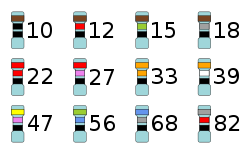
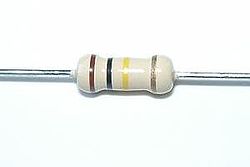
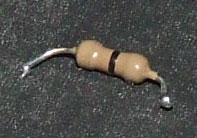
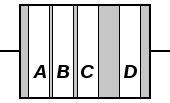
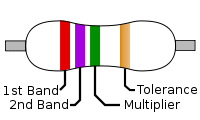
To distinguish left from right there is a gap between the C and D bands.
For example, a resistor with bands of yellow, violet, red, and gold will have first digit 4 (yellow in table below), second digit 7 (violet), followed by 2 (red) zeros: 4,700 ohms. Gold signifies that the tolerance is ±5%, so the real resistance could lie anywhere between 4,465 and 4,935 ohms.
Resistors manufactured for military use may also include a fifth band which indicates component failure rate (reliability
); refer to MIL-HDBK-199 for further details.
Tight tolerance resistors may have three bands for significant figures rather than two, and/or an additional band indicating temperature coefficient
, in units of ppm/K
.
All coded components will have at least two value bands and a multiplier; other bands are optional (italicised below).
The standard color code per EN 60062:2005 is as follows:
A resistor which (read left to right) displays the colors yellow, violet, yellow, brown. The first two bands represent the digits 4, 7. The third band, another yellow, gives the multiplier 104. The value is then 47 x 104 Ω, or 470 kΩ. The brown band shows a tolerance of ±1%.
Resistors use Preferred numbers for their specific values, which are determined by their tolerance
. These values repeat for every decade of magnitude: 6.8, 68, 680, and so forth.
Zero ohm resistors are made as lengths of wire wrapped in a resistor-shaped body which can be substituted for another resistor value in automatic insertion equipment. They are marked with a single black band.
The 'body-end-dot' or 'body-tip-spot' system was used for radial-lead composition resistors sometimes found in very old equipment; the first band was given by the body color, the second band by the color of the end of the resistor, and the multiplier by a dot or band around the middle of the resistor. The other end of the resistor was colored gold or silver to give the tolerance, otherwise it was 20%.
Extra bands on ceramic capacitors will identify the voltage rating class and temperature coefficient characteristics. A broad black band was applied to some tubular paper capacitors to indicate the end that had the outer electrode; this allowed this end to be connected to chassis ground to provide some shielding against hum and noise pickup.
Polyester film and "gum drop" tantalum electrolytic capacitors are also color coded to give the value, working voltage and tolerance.
"1N" prefix was assumed, and the balance of the part number was given by three or four rings.
equipment and in surplus for a generation after the war but are unavailable now.
matches the first letter of the color code, by order of increasing magnitude
. Here are two, one also includes tolerance codes gold, silver, and none:
The colors are sorted in the order of the visible light spectrum: red (2), orange (3), yellow (4), green (5), blue (6), violet (7). Black (0) has no energy, brown (1) has a little more, white (9) has everything and grey (8) is like white, but less intense.
 From top to bottom:
From top to bottom:
The physical size of a resistor is indicative of the power
it can dissipate, not of its resistance.
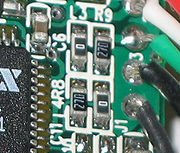 Color-coding of this form is becoming rarer. In newer equipment, most passive components come in surface mount packages. Many of these packages are unlabeled, and those that are labeled normally use alphanumeric codes, not colors.
Color-coding of this form is becoming rarer. In newer equipment, most passive components come in surface mount packages. Many of these packages are unlabeled, and those that are labeled normally use alphanumeric codes, not colors.
In one popular marking method, the manufacturer prints 3 digits on components: 2 value digits followed by the power of ten multiplier
. Thus the value of a resistor marked 472 is 4,700 Ω, a capacitor marked 104 is 100 nF (10x104 pF), and an inductor marked 475 is 4.7 H (4,700,000 µH). This can be confusing; a resistor marked 270 might seem to be a 270 Ω unit, when the value is actually 27 Ω (27×100). A similar method is used to code precision surface mount resistors by using a 4-digit code which has 3 significant figures and a power of ten multiplier. Using the same example as above, 4701 would represent a 470x101=4700 Ω, 1% resistor. Another way is to use the "kilo-" or "mega-" prefixes in place of the decimal point:
For some 1% resistors, a three-digit alphanumeric code is used, which is not obviously related to the value but can be derived from a table of 1% values. For instance, a resistor marked 68C is 499(68) × 100(C) = 49,900 Ω. In this case the value 499 is the 68th entry of the E96 series of preferred 1% values.http://www.radio-electronics.com/info/data/resistor/smd_resistor/smt-resistor-markings-systems.php The multiplier letters are as follows:
Z ×10-3 0.001
Y or R ×10-2 0.01
X or S ×10-1 0.1
A ×100 1
B or H ×101 10
C ×102 100
D ×103 1000
E ×104 10000
F ×105 100000
s used in North American vacuum-tube equipment often were color-coded to identify the leads. Black was the primary connection, red secondary for the B+ (plate voltage), red with a yellow tracer was the center tap
for the B+ full-wave rectfier winding, green or brown was the heater voltage for all tubes, yellow was the filament voltage for the rectifier tube (often a different voltage than other tube heaters). Two wires of each color were provided for each circuit, and phasing was not identified by the color code.
Audio transformers for vacuum tube equipment were coded blue for the finishing lead of the primary, red for the B+ lead of the primary, brown for a primary center tap, green for the finishing lead of the secondary, black for grid lead of the secondary, and yellow for a tapped secondary. Each lead had a different color since relative polarity or phase was more important for these transformers. Intermediate-frequency tuned transformers were coded blue and red for the primary and green and black for the secondary.
Building wiring under the US National Electrical Code and the Canadian Electrical Code is identified by colors to show energized and neutral conductors, grounding conductors and to identify phases. Other color codes are used in the UK and other areas to identify building wiring or flexible cable wiring.
Thermocouple
wires and extension cables are identified by color code for the type of thermocouple; interchanging thermocouples with unsuitable extension wires destroys the accuracy of the measurement.
Automotive wiring is color-coded but standards vary by manufacturer; differing SAE
and DIN
standards exist.
Modern personal computer
peripheral cables and connectors are color coded to simplify connection of speakers, microphones, mice, keyboards and other peripherals, usually according to the PC99 scheme.
A common convention for wiring systems in industrial buildings is; black jacket - AC less than 1000 volts, blue jacket - DC or communications, orange jacket - medium voltage 2300 or 4160 V, red jacket 13,800 volts or higher.
Local area network cables may also have jacket colors identifying, for example, process control network vs. office automation networks, or to identify redundant network connections, but these codes vary by organization and facility.
Resistor
A linear resistor is a linear, passive two-terminal electrical component that implements electrical resistance as a circuit element.The current through a resistor is in direct proportion to the voltage across the resistor's terminals. Thus, the ratio of the voltage applied across a resistor's...
s, but also for capacitor
Capacitor
A capacitor is a passive two-terminal electrical component used to store energy in an electric field. The forms of practical capacitors vary widely, but all contain at least two electrical conductors separated by a dielectric ; for example, one common construction consists of metal foils separated...
s, inductor
Inductor
An inductor is a passive two-terminal electrical component used to store energy in a magnetic field. An inductor's ability to store magnetic energy is measured by its inductance, in units of henries...
s, and others. A separate code, the 25-pair color code
25-pair color code
The 25-pair color code is a color code used to identify individual conductors in a kind of electrical telecommunication wiring for indoor use, known as twisted pair cables . The colors are applied to the insulation that covers each conductor...
, is used to identify wires in some telecommunication
Telecommunication
Telecommunication is the transmission of information over significant distances to communicate. In earlier times, telecommunications involved the use of visual signals, such as beacons, smoke signals, semaphore telegraphs, signal flags, and optical heliographs, or audio messages via coded...
s cables.
The electronic color code was developed in the early 1920s by the Radio Manufacturers Association (now part of Electronic Industries Alliance
Electronic Industries Alliance
The Electronic Industries Alliance was a standards and trade organization composed as an alliance of trade associations for electronics manufacturers in the United States. They developed standards to ensure the equipment of different manufacturers was compatible and interchangeable...
(EIA)), and was published as EIA-RS-279. The current international standard is IEC 60062.
Colorbands were commonly used (especially on resistors) because they were easily printed on tiny components, decreasing construction costs. However, there were drawbacks, especially for color blind
Color blindness
Color blindness or color vision deficiency is the inability or decreased ability to see color, or perceive color differences, under lighting conditions when color vision is not normally impaired...
people. Overheating of a component, or dirt accumulation, may make it impossible to distinguish brown from red from orange. Advances in printing technology have made printed numbers practical for small components, which are often found in modern electronics.
Resistor, capacitor and inductor
It is sometimes not obvious whether a color coded component is a resistor, capacitor, or inductor, and this may be deduced by knowledge of its circuit function, physical shape or by measurement. Resistor values are always coded in ohmOhm
The ohm is the SI unit of electrical resistance, named after German physicist Georg Simon Ohm.- Definition :The ohm is defined as a resistance between two points of a conductor when a constant potential difference of 1 volt, applied to these points, produces in the conductor a current of 1 ampere,...
s (symbol Ω), capacitor
Capacitor
A capacitor is a passive two-terminal electrical component used to store energy in an electric field. The forms of practical capacitors vary widely, but all contain at least two electrical conductors separated by a dielectric ; for example, one common construction consists of metal foils separated...
s in picofarads
Farad
The farad is the SI unit of capacitance. The unit is named after the English physicist Michael Faraday.- Definition :A farad is the charge in coulombs which a capacitor will accept for the potential across it to change 1 volt. A coulomb is 1 ampere second...
(pF), and inductor
Inductor
An inductor is a passive two-terminal electrical component used to store energy in a magnetic field. An inductor's ability to store magnetic energy is measured by its inductance, in units of henries...
s in microhenries (µH).





To distinguish left from right there is a gap between the C and D bands.
- band A is first significant figure of component value (left side)
- band B is the second significant figure
- band C is the decimal multiplier
- band D if present, indicates tolerance of value in percent (no color means 20%)
For example, a resistor with bands of yellow, violet, red, and gold will have first digit 4 (yellow in table below), second digit 7 (violet), followed by 2 (red) zeros: 4,700 ohms. Gold signifies that the tolerance is ±5%, so the real resistance could lie anywhere between 4,465 and 4,935 ohms.
Resistors manufactured for military use may also include a fifth band which indicates component failure rate (reliability
Reliability engineering
Reliability engineering is an engineering field, that deals with the study, evaluation, and life-cycle management of reliability: the ability of a system or component to perform its required functions under stated conditions for a specified period of time. It is often measured as a probability of...
); refer to MIL-HDBK-199 for further details.
Tight tolerance resistors may have three bands for significant figures rather than two, and/or an additional band indicating temperature coefficient
Temperature coefficient
The temperature coefficient is the relative change of a physical property when the temperature is changed by 1 K.In the following formula, let R be the physical property to be measured and T be the temperature at which the property is measured. T0 is the reference temperature, and ΔT is the...
, in units of ppm/K
Kelvin
The kelvin is a unit of measurement for temperature. It is one of the seven base units in the International System of Units and is assigned the unit symbol K. The Kelvin scale is an absolute, thermodynamic temperature scale using as its null point absolute zero, the temperature at which all...
.
All coded components will have at least two value bands and a multiplier; other bands are optional (italicised below).
The standard color code per EN 60062:2005 is as follows:
A resistor which (read left to right) displays the colors yellow, violet, yellow, brown. The first two bands represent the digits 4, 7. The third band, another yellow, gives the multiplier 104. The value is then 47 x 104 Ω, or 470 kΩ. The brown band shows a tolerance of ±1%.
Resistors use Preferred numbers for their specific values, which are determined by their tolerance
Tolerance (engineering)
Engineering tolerance is the permissible limit or limits of variation in# a physical dimension,# a measured value or physical property of a material, manufactured object, system, or service,# other measured values ....
. These values repeat for every decade of magnitude: 6.8, 68, 680, and so forth.
Zero ohm resistors are made as lengths of wire wrapped in a resistor-shaped body which can be substituted for another resistor value in automatic insertion equipment. They are marked with a single black band.
The 'body-end-dot' or 'body-tip-spot' system was used for radial-lead composition resistors sometimes found in very old equipment; the first band was given by the body color, the second band by the color of the end of the resistor, and the multiplier by a dot or band around the middle of the resistor. The other end of the resistor was colored gold or silver to give the tolerance, otherwise it was 20%.
Extra bands on ceramic capacitors will identify the voltage rating class and temperature coefficient characteristics. A broad black band was applied to some tubular paper capacitors to indicate the end that had the outer electrode; this allowed this end to be connected to chassis ground to provide some shielding against hum and noise pickup.
Polyester film and "gum drop" tantalum electrolytic capacitors are also color coded to give the value, working voltage and tolerance.
Diode part number
The part number for diodes was sometimes also encoded as colored rings around the diode, using the same numerals as for other parts. The JEDECJEDEC
The JEDEC Solid State Technology Association, formerly known as the Joint Electron Devices Engineering Council , is an independent semiconductor engineering trade organization and standardization body...
"1N" prefix was assumed, and the balance of the part number was given by three or four rings.
Postage stamp capacitors and war standard coding
Capacitors of the rectangular 'postage stamp" form made for military use during World War II used American War Standard (AWS) or Joint Army Navy (JAN) coding in six dots stamped on the capacitor. An arrow on the top row of dots pointed to the right, indicating the reading order. From left to right the top dots were: black, indicating JAN mica or silver indicating AWS paper. first and second significant figures. The bottom three dots indicated temperature characteristic, tolerance, and decimal multiplier. The characteristic was black for +/- 1000 ppm/ degree c, brown for 500, red for 200, orange for 100, yellow for -20 to +1—ppm/ degree c, and green for 0 to +70 ppm/degree C. A similar six-dot code by EIA had the top row as first, second and third significant digits and the bottom row as voltage rating (in hundreds of volts - no color indicated 500 volts), tolerance, and multiplier. A three-dot EIA code was used for 500 volt 20% tolerance capacitors, and the dots signified first and second significant digits and the multiplier. Such capacitors were common in vacuum tubeVacuum tube
In electronics, a vacuum tube, electron tube , or thermionic valve , reduced to simply "tube" or "valve" in everyday parlance, is a device that relies on the flow of electric current through a vacuum...
equipment and in surplus for a generation after the war but are unavailable now.
Mnemonics
A useful mnemonicMnemonic
A mnemonic , or mnemonic device, is any learning technique that aids memory. To improve long term memory, mnemonic systems are used to make memorization easier. Commonly encountered mnemonics are often verbal, such as a very short poem or a special word used to help a person remember something,...
matches the first letter of the color code, by order of increasing magnitude
Magnitude (mathematics)
The magnitude of an object in mathematics is its size: a property by which it can be compared as larger or smaller than other objects of the same kind; in technical terms, an ordering of the class of objects to which it belongs....
. Here are two, one also includes tolerance codes gold, silver, and none:
- Bad beer rots our young guts but vodka goes well – get some now.
- Black Bears Rarely Outrun Young Grizzlys But Victimize Gray Wolves.
The colors are sorted in the order of the visible light spectrum: red (2), orange (3), yellow (4), green (5), blue (6), violet (7). Black (0) has no energy, brown (1) has a little more, white (9) has everything and grey (8) is like white, but less intense.
Examples

- Green-Blue-Black-Black-Brown
- 560 ohms ± 1%
- Red-Red-Orange-Gold
- 22,000 ohms ± 5%
- Yellow-Violet-Brown-Gold
- 470 ohms ± 5%
- Blue-Gray-Black-Gold
- 68 ohms ± 5%
The physical size of a resistor is indicative of the power
Power (physics)
In physics, power is the rate at which energy is transferred, used, or transformed. For example, the rate at which a light bulb transforms electrical energy into heat and light is measured in watts—the more wattage, the more power, or equivalently the more electrical energy is used per unit...
it can dissipate, not of its resistance.
Printed numbers

In one popular marking method, the manufacturer prints 3 digits on components: 2 value digits followed by the power of ten multiplier
Scientific notation
Scientific notation is a way of writing numbers that are too large or too small to be conveniently written in standard decimal notation. Scientific notation has a number of useful properties and is commonly used in calculators and by scientists, mathematicians, doctors, and engineers.In scientific...
. Thus the value of a resistor marked 472 is 4,700 Ω, a capacitor marked 104 is 100 nF (10x104 pF), and an inductor marked 475 is 4.7 H (4,700,000 µH). This can be confusing; a resistor marked 270 might seem to be a 270 Ω unit, when the value is actually 27 Ω (27×100). A similar method is used to code precision surface mount resistors by using a 4-digit code which has 3 significant figures and a power of ten multiplier. Using the same example as above, 4701 would represent a 470x101=4700 Ω, 1% resistor. Another way is to use the "kilo-" or "mega-" prefixes in place of the decimal point:
- 1K2 = 1.2 kΩ = 1,200 Ω
- M47 = 0.47 MΩ = 470,000 Ω
- 68R = 68 Ω
For some 1% resistors, a three-digit alphanumeric code is used, which is not obviously related to the value but can be derived from a table of 1% values. For instance, a resistor marked 68C is 499(68) × 100(C) = 49,900 Ω. In this case the value 499 is the 68th entry of the E96 series of preferred 1% values.http://www.radio-electronics.com/info/data/resistor/smd_resistor/smt-resistor-markings-systems.php The multiplier letters are as follows:
Z ×10-3 0.001
Y or R ×10-2 0.01
X or S ×10-1 0.1
A ×100 1
B or H ×101 10
C ×102 100
D ×103 1000
E ×104 10000
F ×105 100000
Transformer wiring color codes
Power transformerTransformer
A transformer is a device that transfers electrical energy from one circuit to another through inductively coupled conductors—the transformer's coils. A varying current in the first or primary winding creates a varying magnetic flux in the transformer's core and thus a varying magnetic field...
s used in North American vacuum-tube equipment often were color-coded to identify the leads. Black was the primary connection, red secondary for the B+ (plate voltage), red with a yellow tracer was the center tap
Center tap
In electronics, a center tap is a connection made to a point half way along a winding of a transformer or inductor, or along the element of a resistor or a potentiometer....
for the B+ full-wave rectfier winding, green or brown was the heater voltage for all tubes, yellow was the filament voltage for the rectifier tube (often a different voltage than other tube heaters). Two wires of each color were provided for each circuit, and phasing was not identified by the color code.
Audio transformers for vacuum tube equipment were coded blue for the finishing lead of the primary, red for the B+ lead of the primary, brown for a primary center tap, green for the finishing lead of the secondary, black for grid lead of the secondary, and yellow for a tapped secondary. Each lead had a different color since relative polarity or phase was more important for these transformers. Intermediate-frequency tuned transformers were coded blue and red for the primary and green and black for the secondary.
Other wiring codes
Wires may be color-coded to identify their function, voltage class, polarity, phase or to identify the circuit in which they are used. The insulation of the wire may be solidly colored, or where more combinations are needed, one or two tracer stripes may be added. Some wiring color codes are set by national regulations, but often a color code is specific to a manufacturer or industry.Building wiring under the US National Electrical Code and the Canadian Electrical Code is identified by colors to show energized and neutral conductors, grounding conductors and to identify phases. Other color codes are used in the UK and other areas to identify building wiring or flexible cable wiring.
Thermocouple
Thermocouple
A thermocouple is a device consisting of two different conductors that produce a voltage proportional to a temperature difference between either end of the pair of conductors. Thermocouples are a widely used type of temperature sensor for measurement and control and can also be used to convert a...
wires and extension cables are identified by color code for the type of thermocouple; interchanging thermocouples with unsuitable extension wires destroys the accuracy of the measurement.
Automotive wiring is color-coded but standards vary by manufacturer; differing SAE
SAE International
SAE International is an organization for engineering professionals in the aerospace, automotive, and commercial vehicle industries. The Society is a standards development organization for the engineering of powered vehicles of all kinds, including cars, trucks, boats, aircraft, and others.SAE...
and DIN
Din
DIN or Din or din can have several meanings:* A din is a loud noise.* Dīn, an Arabic term meaning "religion" or "way of life".* Din is one of the ten aspects of the Ein Sof in Kabbalah ....
standards exist.
Modern personal computer
Personal computer
A personal computer is any general-purpose computer whose size, capabilities, and original sales price make it useful for individuals, and which is intended to be operated directly by an end-user with no intervening computer operator...
peripheral cables and connectors are color coded to simplify connection of speakers, microphones, mice, keyboards and other peripherals, usually according to the PC99 scheme.
A common convention for wiring systems in industrial buildings is; black jacket - AC less than 1000 volts, blue jacket - DC or communications, orange jacket - medium voltage 2300 or 4160 V, red jacket 13,800 volts or higher.
Local area network cables may also have jacket colors identifying, for example, process control network vs. office automation networks, or to identify redundant network connections, but these codes vary by organization and facility.
See also
- Electrical wiringElectrical wiringElectrical wiring in general refers to insulated conductors used to carry electricity, and associated devices. This article describes general aspects of electrical wiring as used to provide power in buildings and structures, commonly referred to as building wiring. This article is intended to...
— AC power wiring inside buildings, including standard color codes - 25-pair color code25-pair color codeThe 25-pair color code is a color code used to identify individual conductors in a kind of electrical telecommunication wiring for indoor use, known as twisted pair cables . The colors are applied to the insulation that covers each conductor...
— telecommunications wiring - Other color codes
External links
- IEC 60062 (IEC Webstore)
- 5-band Resistor Color Code Calculator
- Resistor color code calculator (Used to explore E-ranges and color codes.)
- Guide to SMD resistor codes, including alphanumeric codes

